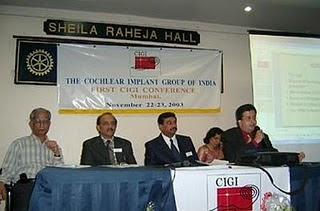COCHLEAR IMPLANTS: HEAR THE WORLD
 A Cochlear Implant (in short “CI”) is a surgically implanted electronic device that provides a sense of sound to a person who is deeply deaf or severely hard of hearing. The cochlear implant is frequently referred to as a bionic ear. Unlike hearing aids, the cochlear implant does not amplify sound, but workings by directly stimulating any functioning auditory nerves inside the cochlea with an electric field. External components of the cochlear implant comprise a microphone, speech processor and an RF transducer or main headpiece coil. A secondary coil is implanted beneath the skull's skin and inductively coupled to the primary headpiece coil. The headpiece coil has an attraction by which it attaches to another attraction placed on the secondary coil often beside the cochlear implant. The implant communicates the incoming signal to the implanted electrodes in the cochlea. The speech processor permits an individual to regulate the sensitivity of the device. The implant gives recipients additional auditory information, which may include sound discrimination well enough to understand speech in calm environments. Post-implantation rehabilitative therapy is often serious to ensuring successful outcomes.
A Cochlear Implant (in short “CI”) is a surgically implanted electronic device that provides a sense of sound to a person who is deeply deaf or severely hard of hearing. The cochlear implant is frequently referred to as a bionic ear. Unlike hearing aids, the cochlear implant does not amplify sound, but workings by directly stimulating any functioning auditory nerves inside the cochlea with an electric field. External components of the cochlear implant comprise a microphone, speech processor and an RF transducer or main headpiece coil. A secondary coil is implanted beneath the skull's skin and inductively coupled to the primary headpiece coil. The headpiece coil has an attraction by which it attaches to another attraction placed on the secondary coil often beside the cochlear implant. The implant communicates the incoming signal to the implanted electrodes in the cochlea. The speech processor permits an individual to regulate the sensitivity of the device. The implant gives recipients additional auditory information, which may include sound discrimination well enough to understand speech in calm environments. Post-implantation rehabilitative therapy is often serious to ensuring successful outcomes.About 150,000 people worldwide have received cochlear implants, with recipients split almost evenly among children and adults. The huge majority are in developed countries due to the high cost of the device, surgery and post-implantation therapy. A little but growing segment of recipients have bilateral implants (one implant in each cochlea).
There is disagreement whether providing cochlear implants to children is ethically justifiable; renewing a century-old debate about models of deafness that often lowest point hearing parents of deaf children next to the Deaf community.
History:
The finding that electrical stimulation to the auditory system can create an awareness of sound occurred around 1790, when Alessandro Volta (the developer of the electric battery) sited metal rods in his own ears and connected them to a 50-volt circuit, experiencing a jolt and hearing a noise "like a thick boiling soup". Other experiments occurred sporadically, until electrical (sound-amplifying) hearing aids began to be developed in earnest in the 20th century.
 The first direct stimulation of an audio nerve with an electrode was performed in the 1950s by the French-Algerian surgeons André Journo and Charles Eyras. They placed wires on nerves exposed during an operation, and reported that the patient heard sounds like "a roulette wheel" and "a cricket" when a current was applied.
The first direct stimulation of an audio nerve with an electrode was performed in the 1950s by the French-Algerian surgeons André Journo and Charles Eyras. They placed wires on nerves exposed during an operation, and reported that the patient heard sounds like "a roulette wheel" and "a cricket" when a current was applied. In 1957, Journo and Eyras of France, William F. House of the House Ear Institute in Los Angeles, and Robin Michelson of the University of California, San Fran Cochlear Implants Co., all created and implanted single-channel cochlear devices in human volunteers, although Michelson is extensively credited with being the creator of the Cochlear Implant (3M Cochlear Implant), which is the majority used throughout the world.
Point Presentation on the Cochlear Implant:
Parallel to the developments in California, in the seventies there were two other groups, working on the development of the Cochlear Implant in Vienna, Austria and Melbourne, Australia. On December 16, 1977 Prof. Kurt Burien implanted the first patient worldwide that received a multichannel cochlear implant. The device has been developed by the Scientists Vineberg and Erwin Hochmair, who founded MED-EL, producer of hearing implants, in 1989. Burien K, Hochmair E, Hochmair-Decoyer IJ. Lesser MR (1979)
 In December 1984, the Australian cochlear implant was approved by the United States Food and Drug Administration to be implanted into adults in the United States. In 1990 the FDA lowered the approved age for implantation to 2 years, then 18 months in 1998, and finally 12 months in 2002, although off label use has occurred in babies as young as 6 months in the United States and 4 months internationally.
In December 1984, the Australian cochlear implant was approved by the United States Food and Drug Administration to be implanted into adults in the United States. In 1990 the FDA lowered the approved age for implantation to 2 years, then 18 months in 1998, and finally 12 months in 2002, although off label use has occurred in babies as young as 6 months in the United States and 4 months internationally.
Throughout the 1990s, the large external components which had been damaged strapped to the body grew smaller and smaller thanks to developments in miniature electronics. By 2006, most school-age children and adults used a small behind-the-ear (BTE) speech processor about the size of a power hearing aid. Younger children have small ears and might mishandle behind-the-ear speech processors; therefore, they often wear the sound processor on their hip in a pack or small harness, or wear the BTE's pinned to their collar, barrette or elsewhere.
On October 5, 2005, the first of 3 recipients was implanted with Cochlear's TIKI device, a totally implantable cochlear implant, in Melbourne, Australia. This was part of a research project conducted by Cochlear Ltd. and the University of Melbourne Department of Otolaryngology under the umbrella of CRC HEAR to be the first cochlear implant system capable of functioning for sustained periods with no external components. The system is capable of providing hearing via the TIKI device in standalone mode (invisible hearing), or via an external sound processor. Although these recipients continue to use their devices successfully today, it will be severial years before a commercial product becomes available.
Point Presentation on the Cochlear Implant:
Parallel to the developments in California, in the seventies there were two other groups, working on the development of the Cochlear Implant in Vienna, Austria and Melbourne, Australia. On December 16, 1977 Prof. Kurt Burien implanted the first patient worldwide that received a multichannel cochlear implant. The device has been developed by the Scientists Vineberg and Erwin Hochmair, who founded MED-EL, producer of hearing implants, in 1989. Burien K, Hochmair E, Hochmair-Decoyer IJ. Lesser MR (1979)
 In December 1984, the Australian cochlear implant was approved by the United States Food and Drug Administration to be implanted into adults in the United States. In 1990 the FDA lowered the approved age for implantation to 2 years, then 18 months in 1998, and finally 12 months in 2002, although off label use has occurred in babies as young as 6 months in the United States and 4 months internationally.
In December 1984, the Australian cochlear implant was approved by the United States Food and Drug Administration to be implanted into adults in the United States. In 1990 the FDA lowered the approved age for implantation to 2 years, then 18 months in 1998, and finally 12 months in 2002, although off label use has occurred in babies as young as 6 months in the United States and 4 months internationally.Throughout the 1990s, the large external components which had been damaged strapped to the body grew smaller and smaller thanks to developments in miniature electronics. By 2006, most school-age children and adults used a small behind-the-ear (BTE) speech processor about the size of a power hearing aid. Younger children have small ears and might mishandle behind-the-ear speech processors; therefore, they often wear the sound processor on their hip in a pack or small harness, or wear the BTE's pinned to their collar, barrette or elsewhere.
On October 5, 2005, the first of 3 recipients was implanted with Cochlear's TIKI device, a totally implantable cochlear implant, in Melbourne, Australia. This was part of a research project conducted by Cochlear Ltd. and the University of Melbourne Department of Otolaryngology under the umbrella of CRC HEAR to be the first cochlear implant system capable of functioning for sustained periods with no external components. The system is capable of providing hearing via the TIKI device in standalone mode (invisible hearing), or via an external sound processor. Although these recipients continue to use their devices successfully today, it will be severial years before a commercial product becomes available.
Since hearing in two ears allows people to localize sounds and to hear better in noisy environments, bilateral (both ear) implants are currently being investigated and operated. Users generally report better hearing with two implants, and tests show that bilateral implant users are better at localizing sounds and hearing in noise. Nearly 3000 people worldwide are bilateral cochlear implant users, including 1600 children. As of 2006, the world's youngest recipient of a bilateral implant was just over 5 months old in Germany 2004.
Parts of the cochlear implant:
The implant is surgically placed under the skin behind the ear. The basic parts of the device include:
Parts of the cochlear implant:
The implant is surgically placed under the skin behind the ear. The basic parts of the device include:
External:
A microphone which picks up sound from the environment
A microphone which picks up sound from the environment
A speech processor which selectively filters sound to priorities audible speech and sends the electrical sound signals through a slim cable to the transmitter.
A transmitter, which is a coil held in position by a magnet placed behind the external ear, and transmits the processed sound signals to the internal device by electromagnetic induction,
Internal:
A receiver and stimulator secured in bone beneath the skin, which converts the signals into electric impulses and sends them through an internal cable to electrodes.
Internal:
A receiver and stimulator secured in bone beneath the skin, which converts the signals into electric impulses and sends them through an internal cable to electrodes.
An array of up to 22 electrodes wound through the cochlea, which send the impulses to the nerves in the scalar tympani and then directly to the brain through the auditory nerve system.
Candidates:
There are a number of factors that decide the degree of success to expect from the operation and the device itself. Cochlear implant centers determine implant candidacy on an individual basis and take into account a person's hearing history, cause of hearing loss, amount of residual hearing, speech recognition ability, health status, and family commitment to aural habilitation/rehabilitation.
A Prime Candidate is described as:
Having severe to profound sensor neural hearing impairment in both ears
Having a functioning auditory nerve
Having lived at least a short amount of time without hearing (approximately 70+ decibel hearing loss, on averiage)
Having good speech, language, and communication skills, or in the case of infants and young children, having a family willing to work toward speech and language skills with therapy
Not benefitting enough from other kinds of hearing aids
Having no medical reason to avoid surgery
Living in or desiring to live in the "hearing world"
Having realistic expectations about results
Having the support of family and friends
Having appropriate services set up for post-cochlear implant aural rehabilitation (through a speech language pathologist, deaf educator, or auditory verbal therapist).
Type of hearing impairment:
People with gentle or moderate antenna neural hearing loss are generally not candidates for cochlear implantation. After the implant is put into position, sound no longer travels via the ear canal and middle ear but will be picked up by a microphone and sent through the device's speech processor to the implant's electrodes inside the cochlea. Thus, the majority candidates have been diagnosed with profound sensor neural hearing loss.
Candidates:
There are a number of factors that decide the degree of success to expect from the operation and the device itself. Cochlear implant centers determine implant candidacy on an individual basis and take into account a person's hearing history, cause of hearing loss, amount of residual hearing, speech recognition ability, health status, and family commitment to aural habilitation/rehabilitation.
A Prime Candidate is described as:
Having severe to profound sensor neural hearing impairment in both ears
Having a functioning auditory nerve
Having lived at least a short amount of time without hearing (approximately 70+ decibel hearing loss, on averiage)
Having good speech, language, and communication skills, or in the case of infants and young children, having a family willing to work toward speech and language skills with therapy
Not benefitting enough from other kinds of hearing aids
Having no medical reason to avoid surgery
Living in or desiring to live in the "hearing world"
Having realistic expectations about results
Having the support of family and friends
Having appropriate services set up for post-cochlear implant aural rehabilitation (through a speech language pathologist, deaf educator, or auditory verbal therapist).
Type of hearing impairment:
People with gentle or moderate antenna neural hearing loss are generally not candidates for cochlear implantation. After the implant is put into position, sound no longer travels via the ear canal and middle ear but will be picked up by a microphone and sent through the device's speech processor to the implant's electrodes inside the cochlea. Thus, the majority candidates have been diagnosed with profound sensor neural hearing loss.
The presence of auditory nerve fibers is essential to the functioning of the device: if these are damaged to such a degree that they cannot receive electrical stimuli, the implant will not work. A small number of individuals with severe auditory neuropathy may also benefit from cochlear implants.
Age of recipient:
Post-lingual deaf adults and pre-lingual deaf children form two distinct groups of potential users of cochlear implants with different needs and outcomes. Those who have lost their hearing as adults were the first group to find cochlear implants useful, in regaining some comprehension of speech and other sounds. If an individual has been deaf for a long period of time, the brain may begin using the area of the brain used for hearing for other functions. If such a person receives a cochlear implant, the sounds can be very disorienting, and the brain often will struggle to readapt to sound.
Age of recipient:
Post-lingual deaf adults and pre-lingual deaf children form two distinct groups of potential users of cochlear implants with different needs and outcomes. Those who have lost their hearing as adults were the first group to find cochlear implants useful, in regaining some comprehension of speech and other sounds. If an individual has been deaf for a long period of time, the brain may begin using the area of the brain used for hearing for other functions. If such a person receives a cochlear implant, the sounds can be very disorienting, and the brain often will struggle to readapt to sound.
 The risk of surgery in the older patient must be considered against the improvement in quality of life. As the devices improve, particularly the sound processor hardware and software, the advantage is often judged to be worth the surgical risk, mainly for the newly deaf elderly patient. The other groups of customers are parents of children born deaf who want to ensure that their children grow up with good spoken language abilities. Research shows that congenitally deaf children who receive cochlear implants at a young age (less than 2 years) have better success with them than congenitally deaf children who first receive the implants at a later age, though the critical period for utilizing auditory information does not close completely until teenage years.
The risk of surgery in the older patient must be considered against the improvement in quality of life. As the devices improve, particularly the sound processor hardware and software, the advantage is often judged to be worth the surgical risk, mainly for the newly deaf elderly patient. The other groups of customers are parents of children born deaf who want to ensure that their children grow up with good spoken language abilities. Research shows that congenitally deaf children who receive cochlear implants at a young age (less than 2 years) have better success with them than congenitally deaf children who first receive the implants at a later age, though the critical period for utilizing auditory information does not close completely until teenage years.Number of Users:
It has been estimated in 2002 that around 10,000 children in the US and an additional 49,000 people worldwide have received Cochlear implants. By the end of 2008, the total number of cochlear implant recipients has grown to an estimated 150,000 worldwide.
Mexico had performed only 55 cochlear implant operations by the year 2000. China will be having 15,000 cochlear implant surgeries on children, which are being paid for by a Taiwanese philanthropist. There is anxiety that the follow-up services in China are not adequate to meet the needs of cochlear implanted children. The operation, post-implantation therapy and ongoing effects.
Cochlear implant as worn by user:
The device is surgically implanted under a general anesthetic, and the operation usually takes from 1½ to 5 hours. First a small area of the scalp directly behind the ear is shaven and cleaned. Then a small in Cochlear Implants ion is made in the skin just behind the ear and the surgeon drills into the mastoid bone and the inner ear where the electrode array is inserted into the cochlea. The patient normally goes home the same day as the surgery, although some cochlear implant recipients stay in the hospital for 1 to 2 days. It is considered outpatient surgery. As with every medical procedure, the surgery involves a certain amount of risk; in this case, the risks include skin infection, onset of tinnitus, damage to the vestibular system, and damage to facial nerves that can cause muscle weakness, or, in worst cases, disfiguring paralysis. There is also the danger of device failure, usually where the in Cochlear Implants ion does not cure properly. This occurs in 2% of cases and the device must be removed. The operation also may destroy any residual hearing the patient may have; as a result, some doctors advise single-ear implantation, saving the other ear in case a biological treatment becomes available in future.
After 1-4 weeks of curative (the wait is usually longer for children than adults), the implant is turned on or activated. Results are typically not immediate, and post-implantation therapy is necessary as well as time for the brain to adapt to hearing new sounds. In the case of congenitally deaf children, audio logical training and speech therapy typically continue for years, though infants can become age suitable in a matter of months. The participation of the child's family in working on spoken language development is considered to be even more significant than therapy. The family can aid development by participating actively in the child's therapy, making hearing and listening interesting, talking about objects and actions, and encouraging the child to make sounds and form of words.
In 2003, the CDC and FDA announced that children with cochlear implants are at a slightly increased danger of bacterial meningitis. Although this hazard is tiny, it is still 30 times higher than children in the general population, without proper vaccinations. Severial users, audiologists, and surgeons also statement that when there is an ear infection causing fluid in the middle ear, it can have an effect on the cochlear implant, leading to temporarily reduced hearing.
The implant has a few effects unrelated to hearing. Manufacturers have cautioned against scuba diving due to the pressures involved, but the depths found in standard recreational diving appear to be safe. The external components must be turned off and removed prior to swimming or showering. Some brands of cochlear implant are unsafe in areas with strong magnetic fields, and thus cannot be used with certain diagnostic tests such as Magnetic Resonance Imaging (MRI), but some are now FDA approved for use with certain strengths of MRI machine. Large amounts of static electricity can cause the device's memory to reset. For this reason, children with cochlear implants are also advised to avoid plastic playground slides. The electronic stimulation the implant creates appears to have a positive effect on the nerve tissue that surrounds it.
Cost:
In the United States, medical costs run from US$ 45,000 to $ 105,000; this includes evaluation, the surgery itself, hardware (device), hospitalization and rehabilitation. Some or all of this may be covered by health insurance. In the United Kingdom, the NHS (National Health Services) covers cochlear implants in full, as does Medicare in Australia. According to the US National Institute on Deafness and Other Communication Disorders, the estimated total cost is $ 60,000 per person implanted.
Efficacy:
A cochlear implant will not cure deafness or hearing impairment, but is a prosthetic substitute for hearing. Some recipients find them extremely effective, others somewhat effective and some feel overiall not as good as off with the implant than without. For people already functional in spoken language who lose their hearing, cochlear implants can be a great help in restoring functional comprehension of speech, especially if they have only missing their hearing for a short time. Individuals who have acquired deaf blindness (loss of hearing and vision combined) may find cochlear implants a radical improvement in their daily life. It may provide them with more information for safety, communication, equilibrium, orientation and mobility and promote interaction within their environment and with other people, reducing separation. Having more auditory information that they may be recognizable with may provide them independent gathering of information to become more independent.
Cost:
In the United States, medical costs run from US$ 45,000 to $ 105,000; this includes evaluation, the surgery itself, hardware (device), hospitalization and rehabilitation. Some or all of this may be covered by health insurance. In the United Kingdom, the NHS (National Health Services) covers cochlear implants in full, as does Medicare in Australia. According to the US National Institute on Deafness and Other Communication Disorders, the estimated total cost is $ 60,000 per person implanted.
Efficacy:
A cochlear implant will not cure deafness or hearing impairment, but is a prosthetic substitute for hearing. Some recipients find them extremely effective, others somewhat effective and some feel overiall not as good as off with the implant than without. For people already functional in spoken language who lose their hearing, cochlear implants can be a great help in restoring functional comprehension of speech, especially if they have only missing their hearing for a short time. Individuals who have acquired deaf blindness (loss of hearing and vision combined) may find cochlear implants a radical improvement in their daily life. It may provide them with more information for safety, communication, equilibrium, orientation and mobility and promote interaction within their environment and with other people, reducing separation. Having more auditory information that they may be recognizable with may provide them independent gathering of information to become more independent.
CONTINUE ON NEXT .... Check Blog Archive








0 comments:
Post a Comment